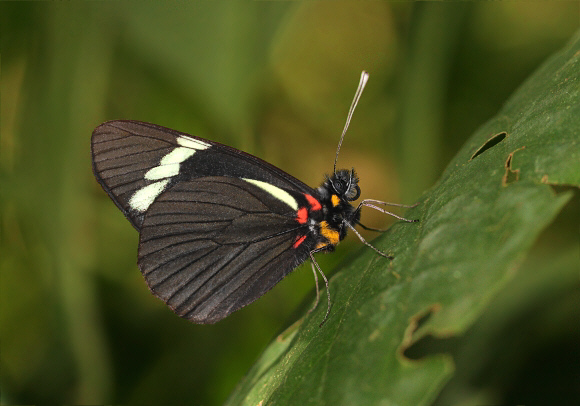 Pereute telthusa, Satipo, Peru – Adrian Hoskins
Pereute telthusa, Satipo, Peru – Adrian Hoskins
Introduction
In the neotropical region there are a total of 192 representatives of the subfamily Pierinae, of which 9 species are placed in the genus Pereute.The butterflies are instantly recognisable by their sooty upperside wings, which in most species are marked with a red or creamy diagonal band on the forewings, and a powdery blue sheen on the hindwings. The undersides are a very dark earthy colour in all species, and have 2 or 3 prominent red spots at the base of the hindwings. All Pereute species have straight white antennae.
Pereute telthusa is confined to the eastern Andes of Peru and Bolivia.
Habitat
As with other Pereute species this butterfly is found in cloudforests, at altitudes between about 700-2200m, and is most frequently encountered in the vicinity of small streams.
Lifecycle
The eggs are yellow, and laid in untidy heaps on the undersides of leaves of Loranthaceae. The larvae are gregarious.
Adult behaviour
Early in the day males perch high in the canopy and chase each other rapidly in wide circles around the tree tops.
In late morning they descend to the understorey, and in the afternoon are sometimes encountered in the vicinity of streams and waterfalls. In common with the males of numerous other butterflies of all families, they imbibe mineralised moisture in order to procure vital salts. However whereas most species choose to imbibe from patches of damp ground, Pereute males have the peculiar habit of sitting in precarious positions, sometimes partially submerged, among pebbles in the middle of fast flowing shallow streams. I have come across this phenomenon numerous times with various Pereute species in Costa Rica, Venezuela, Ecuador and Peru, but can find no logical explanation.
When feeding, Pereute males are exceedingly placid. No amount of molestation will cause them to fly, but conversely when encountered at rest on foliage on narrow forest trails, they are extremely alert and very difficult to approach.
Females are normally only seen when visiting Fuchsia or Eupatorium for nectar.
